
Acorn ink, derived from the mighty oak tree, can be a wonderful addition to your druid practice or art studio. Inks can be used for all manner of useful things, from drawing and artwork to the creation of sigils, writing in a druid’s journal, or engaging in other magical work. In this post, I’ll share a method for making an acorn ink as well as a rust garden (that you can use to strengthen the color of this and other natural inks, like walnut). I’m posting this now because I have found that acorns are best gathered for this not right after they drop, but after they’ve sat on the ground for some time (such as over the winter months). This is a way for you to use acorns pretty much year-round, connect deeply to the energy of the oak tree, and localize your practice.
Ink making was once a common practice before the advent of commercial inks. It was a sacred practice, for the arts of literacy and materials for drawing, writing, and painting were rare and hard to produce. Toady, with the over-abundance of everything at the expense of nature, it’s wise to practice some of these older ways and reattune with the balance, wisdom, and joy of our ancestors. Ink making is actually quite simple and very rewarding and you will get colors that you can’t purchase commercially. If you are interested in this topic, you might also want to check out my earlier post on berry inks.
The Magic of the Oak
Oak trees are special, particularly to those in the druid tradition. The ancient druids did their rituals in groves of oaks. The ancient Irish considered the oak one of the seven sacred trees. Many cultures around the world venerated oaks, which we can see from the use in military symbols and coats of arms throughout the world. The oak is a symbol of strength, persistence, courage, wisdom, and honor.

According to John Michael Greer’s Natural Magic Encyclopedia, Oak is “the preeminent tree of power in ancient symbolism” being of particular use to those who channel high levels of energy, for weather magic, and for earth magic. Acorns themselves are symbols of fertility in ancient times to the present. In the Ogham, Oak is represented by the word “duir”. In ancient Sanskrit, duir literally means “door”. Oaks, then, are not just symbols of strength but doorways to many other things (the inner worlds, worlds of spirit, new journeys, etc). It is tied with the time of midsummer. The oak has very strong wood and was often employed as the Yule Log (where the oak’s power would allow the light to return to the earth once again!) In the Hoodoo traditions, oaks is used to remove hexes or jinxes, usually through a wash. Oak galls (which you can also make ink with, also using iron) are specifically used in the hoodoo tradition to lend power to any other working. So you can see how having some oak ink might be a useful tool! What better opportunity to honor the sacred oak than by making some high-quality ink that can be used for drawing purposes, spiritual journaling, or magical uses.
Making your Ink
Making acorn ink is simple and requires a few basic ingredients and tools
- Acorns, older are better
- Something to crush your acorns with (mortar and pestle, hammer and plastic bag, etc)
- Vinegar (preferably rust garden vinegar, see below)
- Water to cover acorns
- Strainer
Gathering Acorns. I like to make acorn ink early in the spring. The reasoning here is simple–you can easily find last fall’s acorns, and whatever is left, wasn’t a viable food source nor will sprout. So you are using the true “castaways” from the oak–probably acorns that had a few worms, etc. I also find the ink is stronger if you are using older acorns. As always, ask permission to gather and make sure to leave an offering in thanks. To make about a cup of ink, you can gather 2 cups acorns (a cup of ink is a LOT of ink, just FYI!)
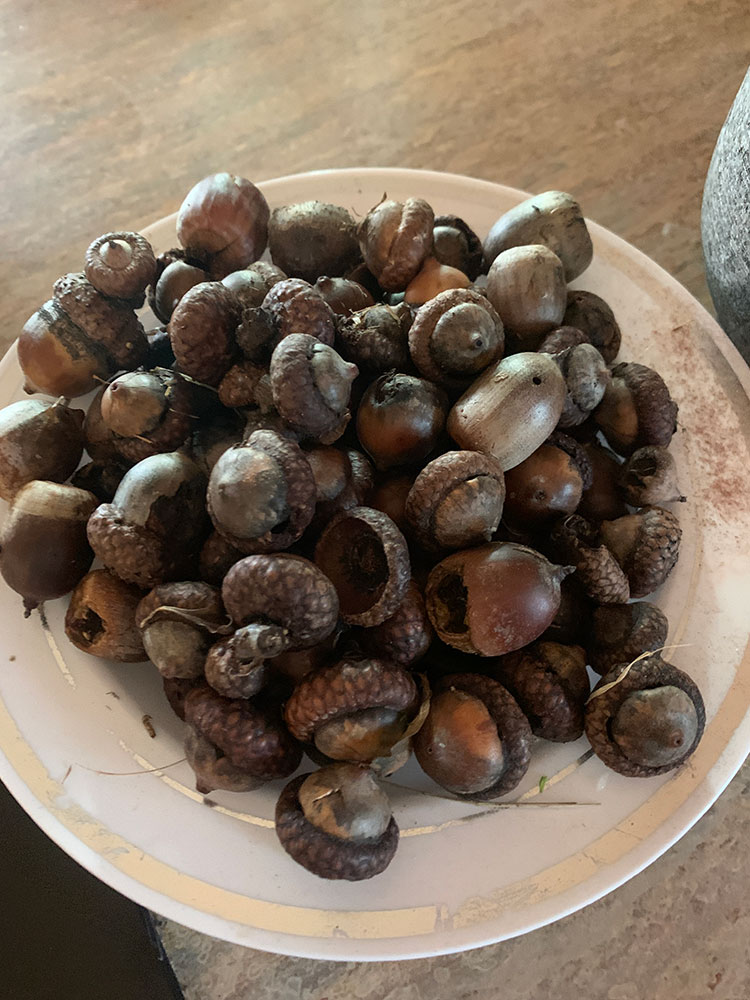
Crushing Acorns. After you’ve harvested your acorns, you will need to crush them. If you have a large mortar and pestle, this works great. You can also crush them easily by getting a thick plastic bag (like an old used feed bag) and using a hammer. Or just crush them up on a large stone. Make sure you save the small bits. The more that you crush, the more effective extraction you will get.
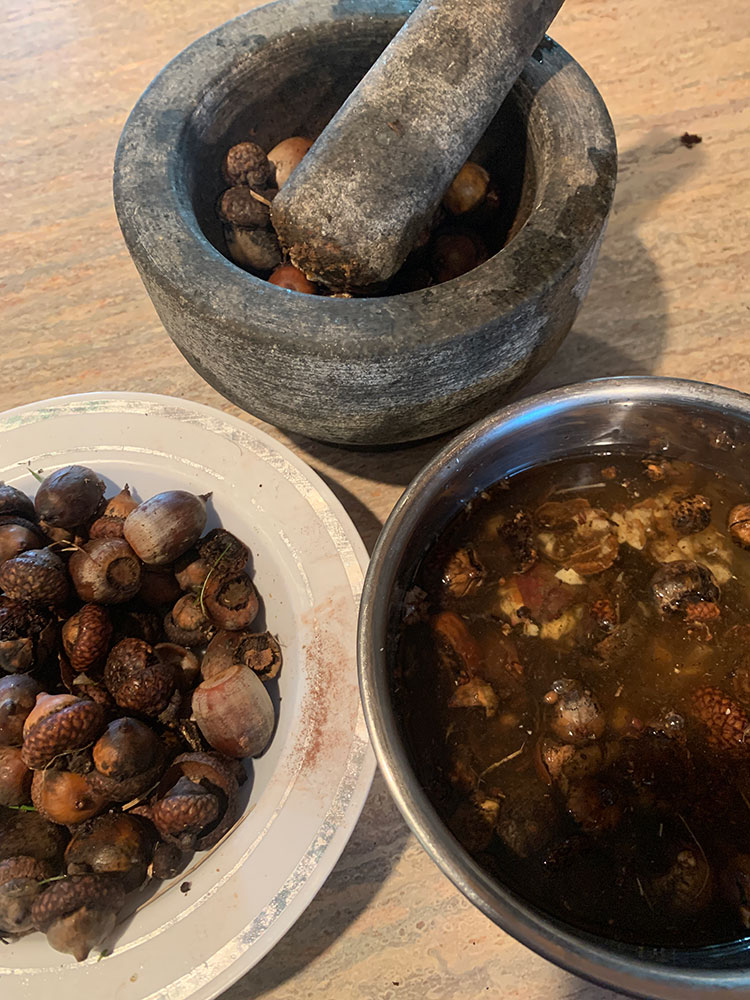
Cover acorns with water. Barely cover your acorns with water, just enough to fully cover them in a small pan. The more water you add, the less of an extraction you will have. So go for a small pot and barely cover them.
Soak overnight. Soak your acorns overnight if possible. While you don’t have to soak overnight, the ink is stronger and more potent if you do.
Simmer. You will want to simmer your acorn mixture for a few hours. It’s better to go long and slow than fast and quick. As you boil, keep a good eye on the water level. Early in my boiling, I might add a little water, but later on, especially in the last hour, I let the water boil off. The more it boils off, the more high-quality ink you will have.
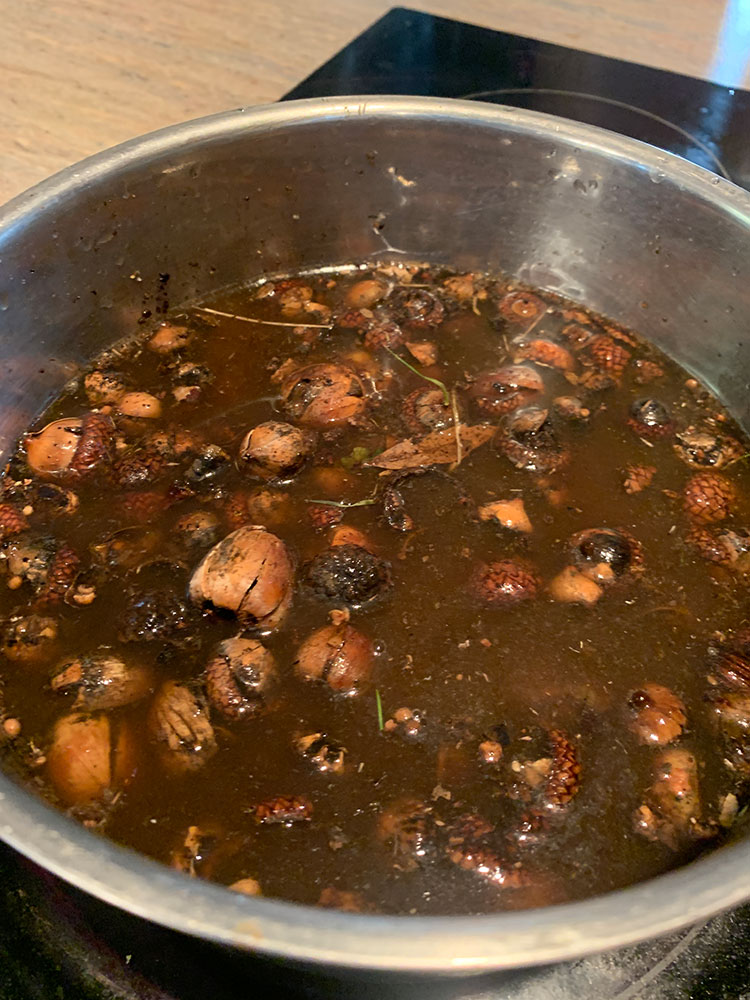
Strain. Next, using a fine-mesh strainer or cheesecloth, strain your ink.
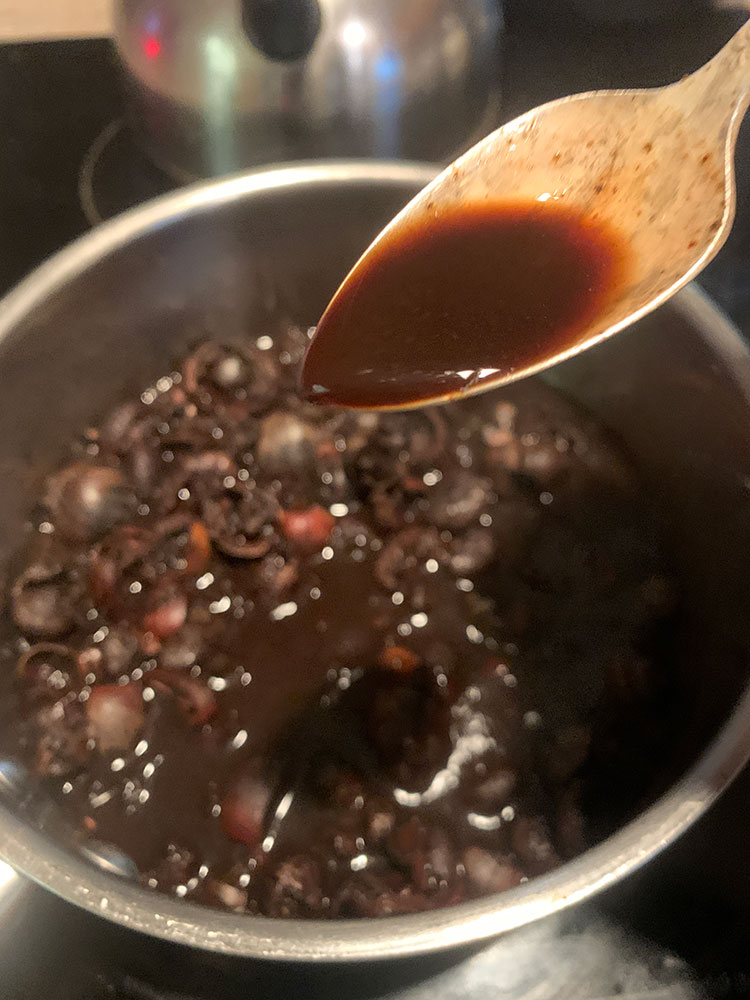
Add Rust garden vinegar or regular vinegar. If you take the time to make a rust garden (highly recommended, see next section), you can add a few tablespoons of rust garden vinegar (about 3 tbsp per cup of ink) to your mixture. This darkens the color and helps preserve it. If you aren’t going to make a rust garden, you still will want to add a tablespoon or two of vinegar to help preserve your ink.
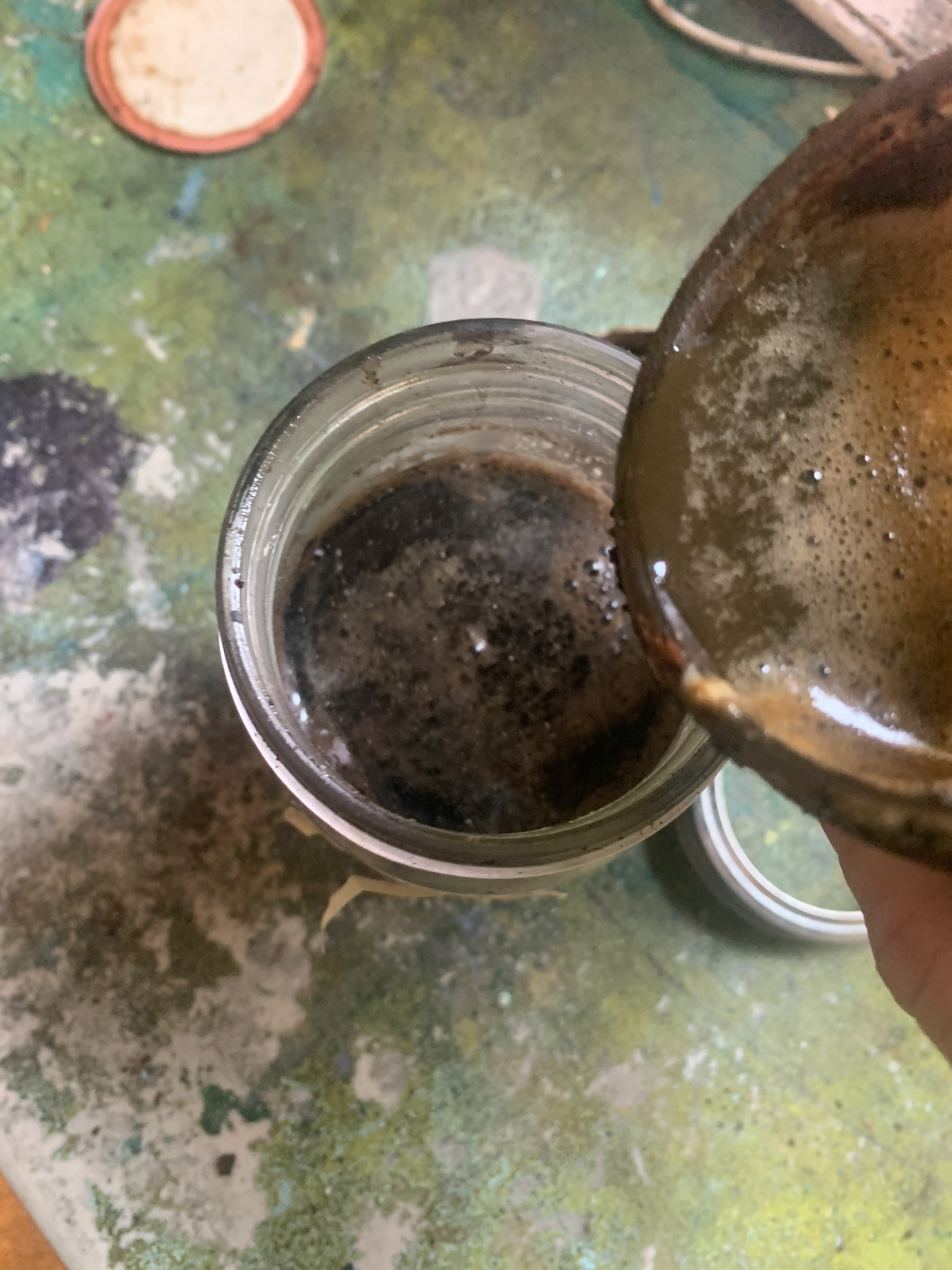
Storage. You can store it in a mason jar with a lid. I recommend keeping it in the fridge as it will last longer. You can keep it in the fridge for quite a while (several years). It is likely that over time, it will develop some bluish mold. Just get a strainer or a fork and remove the mold–the ink is still good.

Optional: Making a Rust Garden
Making a rust garden is a way to improve the quality and color of your acorn ink (it also allows you to make oak gall ink and walnut ink; I’ll cover oak gall ink in an upcoming post). All that you need to start your rust garden are some rusty objects (like iron nails) and some vinegar (any kind will do). Gather up your rusty objects and cover them in vinegar. If you want to help speed it along, you can actually remove the objects, let them be exposed to oxygen for 24 hours, and then put them back in the vinegar vat. I find this to be a little tedious, so instead, I just shake up my rust garden every once in a while and let time do the work. You can start your rust garden in a mason jar. As the items continue to rust, the rusty bits get suspended in vinegar, eventually creating a beautiful dark brown shade. In a few months, you’ll have a very rusty, brown-black vinegar and it will be awesome for making natural inks!
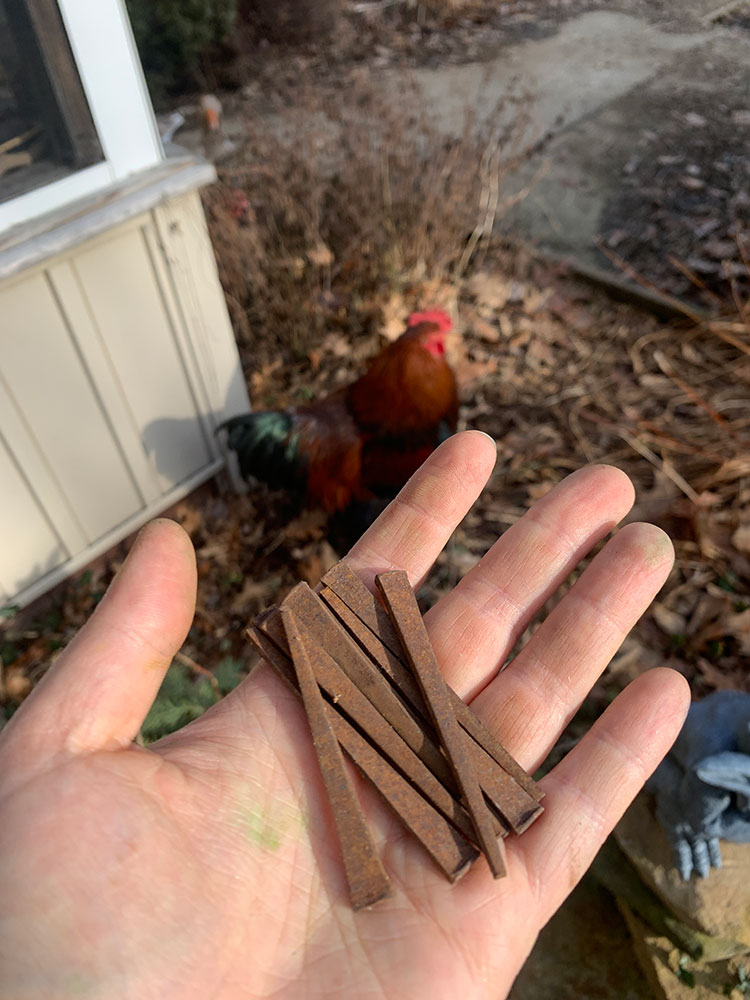
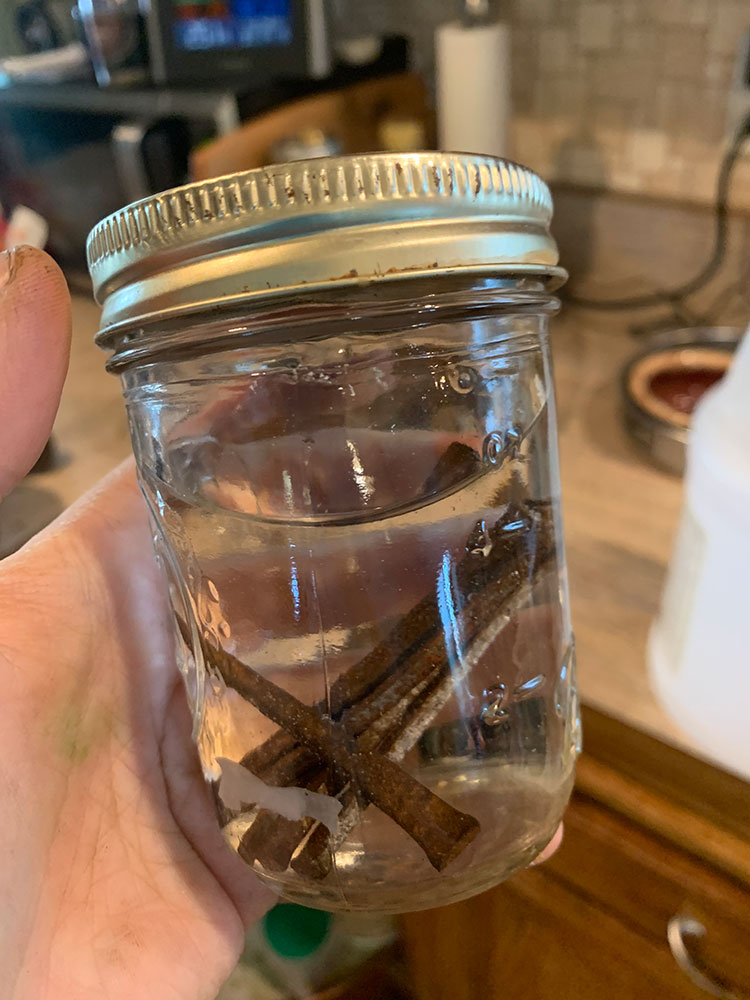
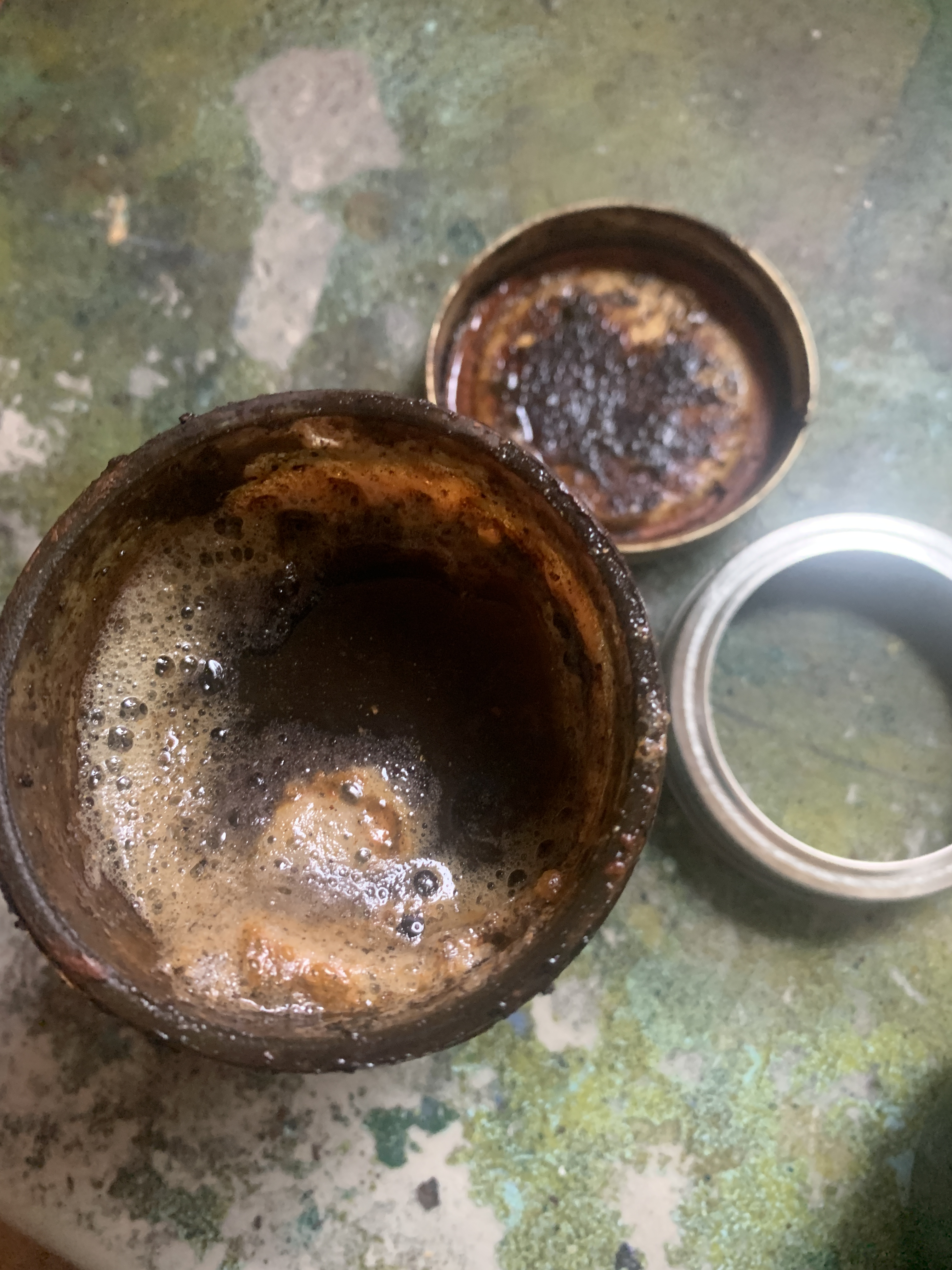
However, this practice takes some time – at least 3-5 months–so keep that in mind. You can always make the ink, then store it in the fridge while your rust garden “grows” and then return to it later (that’s what I did in creating the ink shared in this post). Or you can start your rust garden now, and it will be ready for when this year’s batch of acorns drop in the fall. Be aware here that over time, the jar lid itself will actually rust away–you can see that already happening to my jar here. Thus, I recommend putting either a plastic lid on the jar or else a piece of plastic in between the lid and the jar can help preserve it over time (it will take a few years for the lid to rust away due to the corrosion of the vinegar). Not that I have ANY experience with this happening, haha!
If you use some of your rust garden, you can just add more vinegar and keep letting it rust further. Keep it on a shelf and then anytime you want to make natural inks like acorn, oak gall, or walnut, it will be ready for you!
Using your ink
Once you have your ink, it is ready to use! Here are just a few possibilities for using your ink:
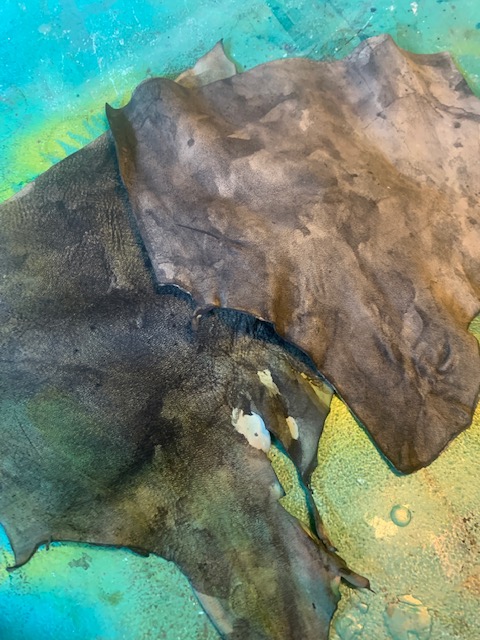
- Pen and ink: An old fashioned dip pen works great with this kind of ink, provided it is well strained. You can use your ink on journals, magical sigils, drawings, and so much more.
- Sigils and other magical work. Consider saving this ink for a special purpose such as writing in your spiritual journal or making sigils.
- Natural arts. You can do a lot of interesting things with such high-quality ink: ink drawings, ink washes, and more.
- Leather and Wood dye. This ink will also dye a lot of surfaces (if you want to use it in this fashion, you’ll have to make large batches, which isn’t unreasonable in mast years when you can harvest abundant acorns). I’m experimenting now with it as a leather stain and its been great!
I hope this post inspires you to try to make some of your own acorn ink! I feel like acorn ink making is a great practice for the aspiring bard or druid!
PS: I hope you like the new look of the Druids Garden Blog! I’ve been using the same theme for so long, I thought a change was necessary. Blessings!




Reblogged this on Paths I Walk.
Thanks for the reblog!
Reblogged this on Blue Dragon Journal.
Thanks for the reblog!
Wonderful share, I love all things natural, and this was new to me, so thank you for sharing.. I came via Eliza’s reblog..
Many thanks you put so much into your post.. I hadnt been here before… So didn’t know your previous theme… And love your background here… I am new here so didn’t see your previous theme…
Many thanks again. 🙂
Thank you Sue! There are almost 450 articles here at the Druid’s garden, so I hope you stay a while!
Reblogged this on Good Witches Homestead.
Thanks for the reblog!
I am so glad I read your posting- I have two grnad children coming to stay for the entire summer and we have endless oaks and acorns , and, rusted objects found along our local freight train tracks ( for the vinegar). Kids are very artistically creative and since there is no summer camp this year, I am looking for unique opportunities for them. Thank you!!! and hope you are staying healthy and safe.
Hi Cirehlan! It sounds like you have a great and artistic summer planned. If you like this, you might check out The Organic Artist and the Organic Artist for Kids. I have found a lot of inspiration in those books! 🙂
Thanks very much for the suggestions.
I posted this on Facebook to share with local others I think would be interested.
Thank you! 🙂
[…] via Making Acorn Ink – Instructions and Recipes — The Druid’s Garden […]
Thanks for the recipe, a good use for the spare acorns that my oak grove produces.
Absolutely! Thank you for reading!
Thank you for sharing this knowledge. I have so many acorns all over my yard, I will definitely give this a try. And a rust garden too!
You are most welcome! Thanks for reading and for the comment 🙂
Great post, but since I work in an archive, I feel compelled to point something out. I would be careful using this ink to keep a journal, or any document meant to last. Based on the recipe, it would be acidic and full of iron oxide, which would mean it’s not archival. It’s probably chemically similar to iron gall ink, which is prone to serious fading over time. For journals, I’d recommend india ink.
Thanks for the heads up. I was suspecting this to be true. I wonder if there is anything that could be added to make it more archival- probably not but it will be fun to experiment with it with my grand kids
.
I would recommend walnut ink if you want it to be archival. You can also omit the vinegar and make the ink straight without anything else and then it will be more archival than with the iron/vinegar bath!
Thanks again. I have a friend with a black walnut tree and I will ask if they have any old drops
That’s a question for people who have more knowledge than I do, but my one recommendation would be to leave rust out of the equation. Metals are a big part of what makes inks less archival.
You would want to leave the salt, rust, and vinegar all out of the equation. Make the ink with just the acorns, see how well you can cook it down!
What thorough and beautiful instructions! Thank you so much for sharing in so much detail! <3
[…] Making Acorn Ink – Instructions and Recipes – inkoust ze žaludů […]
Thank you for this ancient crafting lesson. I am looking forward to making this sacred ink. Blessed Be
Awesome, glad it was useful for you! Look to the fall when the Acorns drop… 🙂
Hi!
I have my own oak and ash woodland and I really want to make my own acorn ink !
I have got a book with a recipe but it says that you should slow cook the acorns for THREE DAYS!!
This has put me off for a long time because I can’t safely leave a pot going for that long indoors and it would be very hard to do on a campfire. So how long do you cook your acorns ? Why would anyone do it for three days!? I am just starting a rust garden ready for the spring. The recipe also says add hide glue? Do I need this? Many thanks in anticipation of hearing from you. Best wishes Rachel.
Hi Rachel,
I’m thinking they probably meant to use a crock pot for three days. That would certainly make sense and make a nice ink. But the ink that I made I only cooked for maybe 2-3 hours. It was enough. Adding rust from the rust garden is good (tip here–the metal lids will rust, so I had to relocate mine to a completely plastic container; an old cat treat container!)
In terms of hide glue, it is an optional ingredient. Adding a small amount will improve the viscosity of the ink. This is especially helpful if you are using a dip pen with the ink (less important if you are using it with a small brush). If you don’t have hide glue, you could also use a little bit of gum arabic (you can buy it powdered or prepared at an art store).
I hope this helps! Blessings!
Hi Dana,
Thank you for your reply.
Now I know I can cook the acorns for a shorter time I will give it a go. I have started my rust garden so in a few months I should be able to draw with my new ink!
I do have some gum Arabic, will give it a try,
Thank you for your advice,
Best wishes Rachel
Hi Rachel,
Awesome! Let me know how it goes for you :).
Yes, I will do…if I draw anything worth showing I will send it!!
I really appreciate your advice, thank you 😊
Does anyone know how to make blueberry or other berry inks? I have made the acorn, the rust, some red beet and , I would like to add to my options. Also, any green colored recipes? I love The Druid – thank you. It is always calming to read your writings.
Hi Cindy! Yes! Here you go https://druidgarden.wordpress.com/2012/08/29/making-berry-inks-huckleberry-raspberry-blackberry-pokeberry-etc/
The berry inks are pretty similar to how you likely made the beet ink. It is the right time for berry inks here in Eastern North America, at least!
Hi, I purchased some beet powder to use to make ink or watercolour pigment to skip the mess with fresh beets. I don’t know if it will work yet but I will experiment and share my results!
Hi Cindy,
I have a book called the organic artist by Nock Neddo. He has berry, beet and acorn recipes and also how to make your own brushes and other art materials. I recommend it, some things are worth a try but some things seem over complicated at times…I’m sure they can be made easier ! That’s why I came here for advice from Dana!! Rachel
I highly recommend Nick Neddo’s work! He’s fantastic and really honors plants and the process of harvesting and producing natural art supplies. He also has a great book for kids :).
Just found your acorn ink recipe and used it for pecans. The ink isn’t as strong I think but I’ve gathered acorns to try next. Also started a rust garden. I signed up for the newsletter and can’t wait to look further at your blog. Such a treasure of information. Thank you
Cool! I haven’t tried it with pecans but I’m glad it worked :).
[…] Read more at The Druids Garden […]
Thank you for a fascinating read. I have re-blogged on my site https://thepurpleraven.co.uk/Blog/making-acorn-ink-instructions-and-recipes-from-the-druids-garden/
Hi Lydia,
Sure! Glad you found the information useful! 🙂